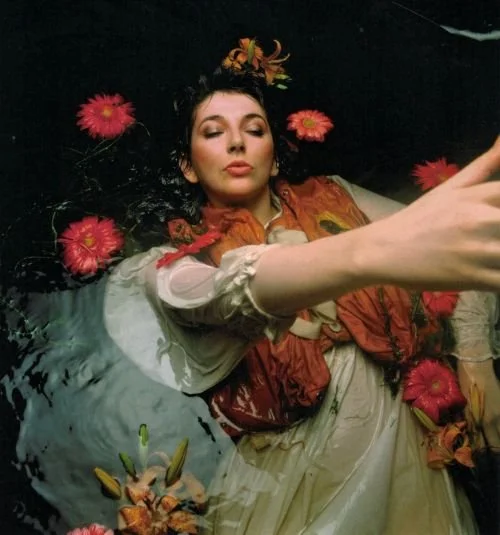FEATURE:
Kate Bush’s Hounds of Love at Forty
IN THIS PHOTO: Kate Bush in 1985/PHOTO CREDIT: Guido Harari
Ten: Waking the Witch
__________
THIS song is a bit…
of a turning point in The Ninth Wave. Kate Bush’s Hounds of Love turns forty on 16th September. I am running a series of features that looks inside all of the songs and aspects around the album. The third song on The Ninth Wave, the conceptual second side of the album, is perhaps the scariest and most urgent. It is Walking the Witch. Following Under Ice, we sense the heroine trapped under ice and beneath the water. Waking the Witch is the song where voices urge her to wake up and keep going. The next song, Watching You Without Me, is more haunted. Family and friends waiting for the arrival of the heroine/Bush but she is not there. I am going to explore Waking the Witch in more detail. For that, I will bring in Leah Kardos’s 33 1/3 book, Hounds of Love. Kardos unpicks the song and goes inside the composition. Before I get there, this article from the Kate Bush Encyclopedia is interview archive where Bush discussed one of the most thrilling and memorable songs on Hounds of Love:
“These sort of visitors come to wake them up, to bring them out of this dream so that they don’t drown. My mother’s in there, my father, my brothers Paddy and John, Brian Tench – the guy that mixed the album with us – is in there, Del is in there, Robbie Coltrane does one of the voices. It was just trying to get lots of different characters and all the ways that people wake you up, like you know, you sorta fall asleep at your desk at school and the teacher says “Wake up child, pay attention!”. (…) I couldn’t get a helicopter anywhere and in the end I asked permission to use the helicopter from The Wall from The Floyd, it was the best helicopter I’d heard for years for years [laughs].
I think it’s very interesting the whole concept of witch-hunting and the fear of women’s power. In a way it’s very sexist behavior, and I feel that female intuition and instincts are very strong, and are still put down, really. And in this song, this women is being persecuted by the witch-hunter and the whole jury, although she’s committed no crime, and they’re trying to push her under the water to see if she’ll sink or float.
Richard Skinner, ‘Classic Albums interview: Hounds Of Love. Radio 1 (UK), aired 26 January 1992”.
PHOTO CREDIT: John Carder Bush
Kate Bush performed this track, and the entirety of The Ninth Wave, during the 2014 residency in Hammersmith. As part of the majestic Before the Dawn, I can imagine Waking the Witch was one of the standout moments. I would love to have been at one of the twenty-two dates! There is a lot of detail from Leah Kardos about Waking the Witch. I can’t include all of it. However, I want to select some highlights. Voices urging the heroine to wake up: “Voices speak from various locations in the stereo space, urging the woman to wake up, some of them sound like family (‘Wake up, sleepy head!”), another like a scolding schoolmistress (‘Wake up, child – pay attention!’)”. Bush is masterful when it comes to layering vocals perfectly. The answer machine messages that play during The Dreaming’s All the Love. She can weave these different accents and people together to create something head-spinning. Waking the Witch is such a busy track. Leah Kardos writes how we hear various voices – including Robbie Coltrane, whale song, and John Carder Bush’s voice, “from the back of the right speaker peeks out to stage-whisper ‘Over here!’”. The explosion happens after some brief build-up. “Most shocking is Bush’s frantic voice, cutting in and out as she pleads , ‘Listen to me, help me, help me baby’”. It is, as Kardos suggests, the panic-stricken sounds of someone drowning. I often wonder whether Bush/the heroine made it out of the song. Whether this is the moment she succumbs. That garbled cry was achieved by “quickly moving the record switch on the tape machine”. That was the source of a heated argument between Kate Bush and her engineer and then-boyfriend, Del Palmer. In a later interview, Palmer admitted he had to eat humble pie and was wrong!
The heroine goes from this drowning and scared person to someone accused of witchcraft She is put on trial and condemned. “Witch ‘swimming’ or ‘ducking’ was the practice of tying up and dunking an accused woman into the body of water to see if they sank or floated”. It is a terrifying and tense moment that brings so much story and twist to the song. “With its monstrous voice effect (Eventime Harmonizer set to minus-two octaves), Bush’s Witchfinder subjects the accused to such tests (‘You won’t burn, you won’t bleed, confess to me girl’)”. These tests including subjecting the accused to burning and pricking. The feeling that witches were impervious to pain and would have a bloodless mark. It was based around belief, though it was sexism and misogyny. A fascinating thing to bring into the middle of a 1985 album! Bush herself must have felt like a witch being judged and on trial. Subject to so much blatant misogyny through her career! I do not know that background voices “sing lines adapted from the halyard sea shanty Blood Red Shoes. The tune was popularized by folk revivalist A.L. (Bert) Lloyd”. Bush does some riffing on Lloyd’s lines. “Pinks and posies, red, red roses go down”. Bush was no stranger to a sea shanty. Leah Kardos remarks how the B-side of Hounds of Love’s title single was a cover of The Handsome Cabin Boy. It was originally by Lloyd and Ewan MacColl. “The music breaks away from the C# minor for a counter phrase that swirls with the sound of church bells and woozy spiralling guitar figures around E minor. Bush murmurs snatches of Catholic Vulgate scripture that she may be forgetting or getting wrong: ‘Spiritus sanctus in nomine no-no-no-no’ (the name of the Holy Spirit, no) and later ‘Deus et dei domino no-no-no-no’ (God and God’s lord, no)”. The Witchfinder questions the innocence of the woman and delivers the verdict. Kardos writes about the line, “Help this blackbird, there’s a stone around my leg”. With the sound of a helicopter coming in and yelling at the woman to get out of the water – the same helicopter sample used on Pink Floyd’s The Wall -, there is mystery around the blackbird and what that references.
Leah Kardos theorises it could be a reference to Elizabeth George Speare’s 1958 novel, The Witch of Blackbird Pond. The lead is seen as a witch and viewed with suspicion after diving into the water to retrieve a child’s toy and she has this ability to swim. That was seen as unusual. Bush remarked how female instinct and intuition was put down and people fear a woman’s power. She channelled all of this in Waking the Witch. I know I have published a lot of this information before. Quoted from Leah Kardos. However, as not much is written about the track and it is almost forty years since Hounds of Love was released, it warrants another inclusion. I want to include some information from this feature from earlier in the year that provides some fascinating perspectives and insight into Waking the Witch:
“The accuser is distorting her words and ignoring her cries so she imagines herself turning into a blackbird (the blackbird being Bush’s favourite singer, as she once told a bemused interviewer):
I question your innocence
She's a witch (help this blackbird, there's a stone around my leg)
Ha, damn you, woman
(Help this blackbird, there's a stone around my leg)
What say you, good people (guilty, guilty, guilty)
Well, are you responsible for your actions? (This blackbird)
Not guilty (help this blackbird)
Wake up the witch
The song ends with the sound of a rescue helicopter and a cry to ‘get out of the water.’ A witch trial is not an obvious place for the drowning protagonist’s thoughts to have taken them, perhaps the woman half-remembers a story of witch ducking and has imagined herself in the victim’s place as the water seems to bear down on her with the fury of persecution. Identifying with an accused witch also brings a particularly female sensibility to this musical story.
I think of the women of Afghanistan singing in defiance of the Taliban’s femicidal death cult, punished for doing what blackbirds can do freely. This feels like a song for anyone who is drowning, but I also think it’s worth noting that the violent imagery here brings with it the will to stay awake. Unlike the gentle suicide suggested by ‘And Dream of Sheep,’ a sinister song masquerading as a lullaby, this song pricks our drowning woman awake and lights a fire of determination underneath her. It’s at the climax of her persecution that rescue suddenly arrives. This also subverts the title of the song: ‘Waking the Witch’ was the name for the practice of sleep deprivation used as torture for securing a confession. Here, staying awake will save the woman’s life.
If you’re interested in the real history of witch trials and stories of defiance, make sure to read Marion Gibson’s Witchcraft, A History in 13 trials which I reviewed here. I wrote about whether or not we still find witches scary back in my Macbeth entry in ‘Horror Moments: Shakespeare Edition’ which you can read here”.
A very important song on The Ninth Wave, Waking the Witch is a moment of history, sexism, struggle, defiance and terror. Did the heroine survive and respond to the voices? Are these dying words she hears? In terms of the production and the vocal layers, this is Kate Bush at her very best as producer! Busy and dripping in darkness and violence, there is also sweetness and this chance of hope. Watching You Without Me is a much calmer affair. Where we maybe sense the heroine is a ghost. Or that is how she appears to her family. A remarkable switch in terms of mood and the story. That is a song I will investigate next time. Now, for this feature, I was keen to dive inside the terrifying Waking the Witch. It is the eighth track from Kate Bush’s landmark…
FIFTH studio album.



